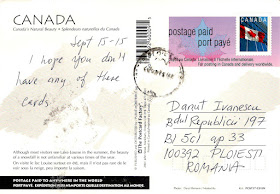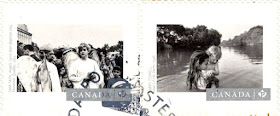 |
| 0861 Banff National Park - Peyto Lake |
Posted on 14.11.2013, 16.08.2014, 25.07.2015, 10.10.2015, 01.01.2017, 24.01.2017
Renowned for their scenic splendor, the Canadian Rocky Mountain Parks are comprised of Banff, and Jasper parks in Alberta, and Kootenay, Yoho, Mount Robson, Mount Assiniboine and Hamber parks in British Columbia. Together, they exemplify the outstanding physical features of the Rocky Mountain Biogeographical Province. Classic illustrations of glacial geological processes - including icefields, remnant valley glaciers, canyons and exceptional examples of erosion and deposition - are found throughout the area. The Burgess Shale Cambrian and nearby Precambrian sites contain important information about the earth's evolution.
 |
| 1947 Banff National Park - Lake Louise |
Located at 110-180km west of Calgary, Banff National Park is Canada's oldest national park, established in 1885. Named for an early trail guide and trapper, Peyto Lake is a glacier-fed lake formed in a valley of the Waputik Range, between Caldron Peak, Peyto Peak and Mount Jimmy Simpson, at an elevation of 1,860m. During the summer, significant amounts of glacial rock flour flow into the lake, and these suspended rock particles give the lake a bright, turquoise colour. The lake is fed by the Peyto Creek, which drains water from the Caldron Lake and Peyto Glacier, and flows into the Mistaya River. Lake Louise, named Lake of the Little Fishes by the Stoney Nakota First Nations people, is also a glacial lake within the same park, drained through the 3 km long Louise Creek into the Bow River, and having characteristics similar to Peyto Lake.
 |
| 1184 Jasper National Park - Athabasca Glacier |
One of the icefield of Canadian Rocky Mountain Parks is Columbia Icefield, which lies partly in the northwestern tip of Banff National Park and the southern end of Jasper National Park. It is about 325 km² in area, 100 to 365m in depth and receives up to 7m of snowfall per year. The icefield feeds eight major glaciers, including Athabasca Glacier. It currently recedes at a rate of about 5m per year and has receded more than 1.5km in the past 125 years and lost over half of its volume. The glacier moves down from the icefield at a rate of several centimetres per day. Due to its close proximity to the Icefields Parkway, between the Alberta towns of Banff and Jasper, and rather easy accessibility, it is the most visited glacier in North America.
 |
| 1775 Jasper National Park - Maligne Lake |
Jasper National Park is the largest national park in the Canadian Rockies, and includes the glaciers of the Columbia Icefield, hot springs, lakes, waterfalls and mountains. Located 44km south of Jasper town, Maligne Lake (from the French word for malignant or wicked) is famed for the colour of its water, the surrounding peaks, the three glaciers visible from the lake and Spirit Island. It is fed and drained by the Maligne River, which enters the lake on its south side, near Mount Unwin and drains the lake to the north. Spirit Island is a tiny tied island, frequently photographed, a view which many people associate with the Canadian Rockies.
 |
| 2923 Yoho National Park - Emerald Lake |
Located in southeastern British Columbia, Yoho National Park was named after a Cree expression of awe and wonder. Emerald Lake is the largest of Yoho's 61 lakes and ponds, as well as one of the park's premier tourist attractions. It is enclosed by mountains of the President Range, as well as Mount Burgess and Wapta Mountain. This basin traps storms, causing frequent rain in summer and heavy snowfalls in winter. This influx of moisture works with the lake's low elevation to produce a unique selection of flora. Due to its high altitude, the lake is frozen from November until June. The vivid turquoise color of the water, caused by powdered limestone, is most spectacular in July as the snow melts from the surrounding mountains.
 |
| 2934 Yoho National Park - A fossil of Bathyuriscus rotundatus |
The Burgess Shale, located in Yoho National Park, has among the world's richest deposits of rare fossils. Bathyuriscus is an extinct genus of Cambrian trilobite. It was a nektobenthic predatory carnivore. The genus Bathyuriscus is endemic to the shallow seas that surrounded Laurentia. Its major characteristics are a large forward-reaching glabella, pointed pleurae or pleurae with very short spines, and a medium pygidium with well-impressed furrows.In Greek, bathys means deep, and oura - tail, so Bathyuriscus means a trilobite with a deep tail. On the other hand, rotundatus comes from the Latin rotundus - round, presumably alluding to the rounded outline of the dorsal shield.
About the stamps
On the postcard 0861
The first two stamps, in se-tenant format, was illustrated by Suzanne Duranceau, and was issued on June 15, 2012, for celebrate the Bicentennial of the War of 1812, which had as belligerents on the one hand the United States of America and on the other the United Kingdom of Great Britain and Ireland, its North American colonies and its Indian allies. The stamps depict two important leaders rise in this war, British Major-General Sir Isaac Brock and War Chief Tecumseh. The facial expressions of the two men depict mutual respect. The background of the Brock stamp shows a European settlement, as it would have looked circa 1812. Chief Tecumseh is shown with encampments scattered around him, indicating that more than one tribe has taken to arms under his command. Stamp designer Susan Scott notes that, "The setting is a visual representation of the motivation for each man - this is what they were fighting for. And the body of water speaks to the dominance of the British naval power."
The last stamp is part of a series depicting seven Canadian National Hockey League Teams, issued on September 13,2013. All the stamps have the same face value, 63c:
• Montreal Canadiens
• Ottawa Senators
• Toronto Maple Leafs
• Winnipeg Jets
• Edmonton Oilers
• Calgary Flames - It's on the postcard 0861
• Vancouver Canucks
On the postcard 1947
This is a prepaid postcard
On the postcard 1184, and 1775
The stamp is part of a series of definitive stamps, Baby Wildlife, about which I wrote here.
On the postcard 2923
The first stamp is part of the series Beneficial Insects, about which I wrote here.
The last stamp, designed by Kosta Tsetsekas, was issued on February 15, 2015 to celebrate the 50th Anniversary of the Canadian Flag.
On the postcard 2934
• Geoffrey James - Alex Colville on the Tantramar Marshes / 1970 (1.20 CAD)
• Sam Tata - Angels, Saint-Jean-Baptiste Day / 1962 (P) - It's on the postcard 2934
• Larry Towell - Isaac’s First Swim / 1996 (P) - It's on the postcard 2934
• Conrad Poirier - Friends and Family and Trips. In front of Simpsons / 1936 (P)
• Nina Raginsky - Shoeshine Stand / 1974 (P) - It's on the postcard 2934
• Geneviève Cadieux - La Voie Lactée / 1992 (2.50 CAD)
• Harold Mortimer-Lamb - Southam Sisters / 1915-1919 (P)
References
Canadian Rocky Mountain Parks World Heritage Site - Wikipedia
Peyto Lake - Wikipedia
Canadian Rocky Mountain Parks - UNESCO official website
Athabasca Glacier- Wikipedia
Jasper National Park - Wikipedia
Maligne Lake - Wikipedia
Emerald Lake (British Columbia) - Wikipedia
Yoho National Park - Wikipedia
Sender 0861: Jason Thomson (direct swap)
Sent from Ottawa (Ontario / Canada), on 17.10.2013
Photo: V. Sokolowski
Sender 1947: Denise
Sent from Montreal (Quebec / Canada), on 15.15.2015
Photo: Daryl Benson / Masterfile
Sender 1184: Katie
Sent from Toronto (Ontario / Canada), on 15.04.2014
Photo: Bela Baliko / 2012
Sender 1775: Heli Paudel
Sent from Calgary (Alberta / Canada), on 15.04.2015
Photo: Larry Fisher
Sender 2923: M.Y. (direct swap)
Sent from Red Deer (Alberta / Canada), on 25.11.2015
Photo: Bob Hart
Sender 2934: M.Y. (direct swap)
Sent from Red Deer (Alberta / Canada), on 25.11.2015










No comments:
Post a Comment